Abstract
Passive stiffness and hydroxyproline content of myocardium hypertrophied by pressure-loading were determined in kittens 2, 8-16, and 24-52 wk after pulmonary artery banding, which initially elevated right ventricular systolic pressure by 10-15 mm Hg. Right ventricular mass increased by approximately 75%, three-quarters of which occurred during the first 2 wk after banding. Passive stiffness was assessed from resting length-tension relations of isometrically contracting isolated right ventricular papillary muscles. Stiffness constants, alpha and beta were determined from the relationship sigma = alpha (e beta epsilon - 1) where sigma = stress and epsilon = Lagrangian strain. Elastic stiffness (d sigma/d epsilon) was derived from: d sigma/d epsilon = beta sigma + beta alpha. Right ventricular hydroxyproline increased in proportion to muscle mass so that hydroxyproline concentration remained unchanged after banding. Both alpha, beta, and elastic stiffness-stress relations were similar to values in nonbanded controls. Thus, we did not observe an increase in passive stiffness or hydroxyproline concentration of pressure-stiffness or hydroxyproline concentration of pressure-induced hypertrophied myocardium in contrast to most previous studies.
Full text
PDF
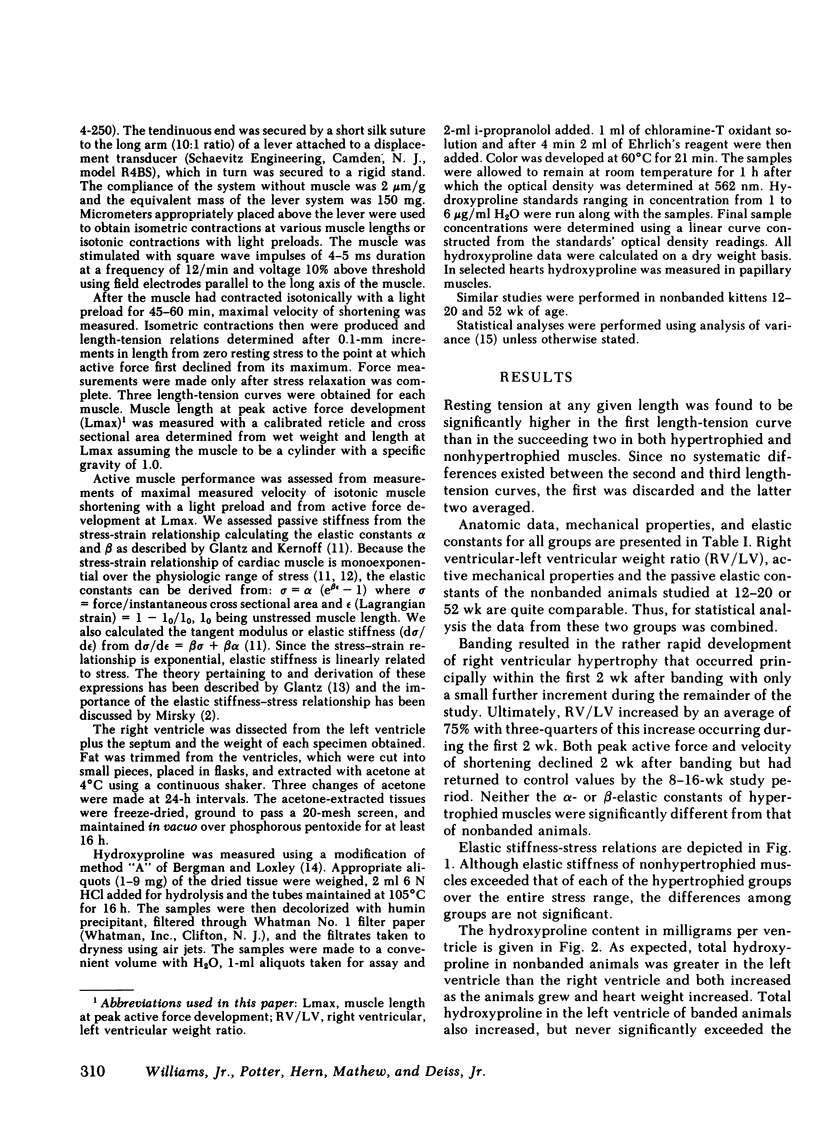
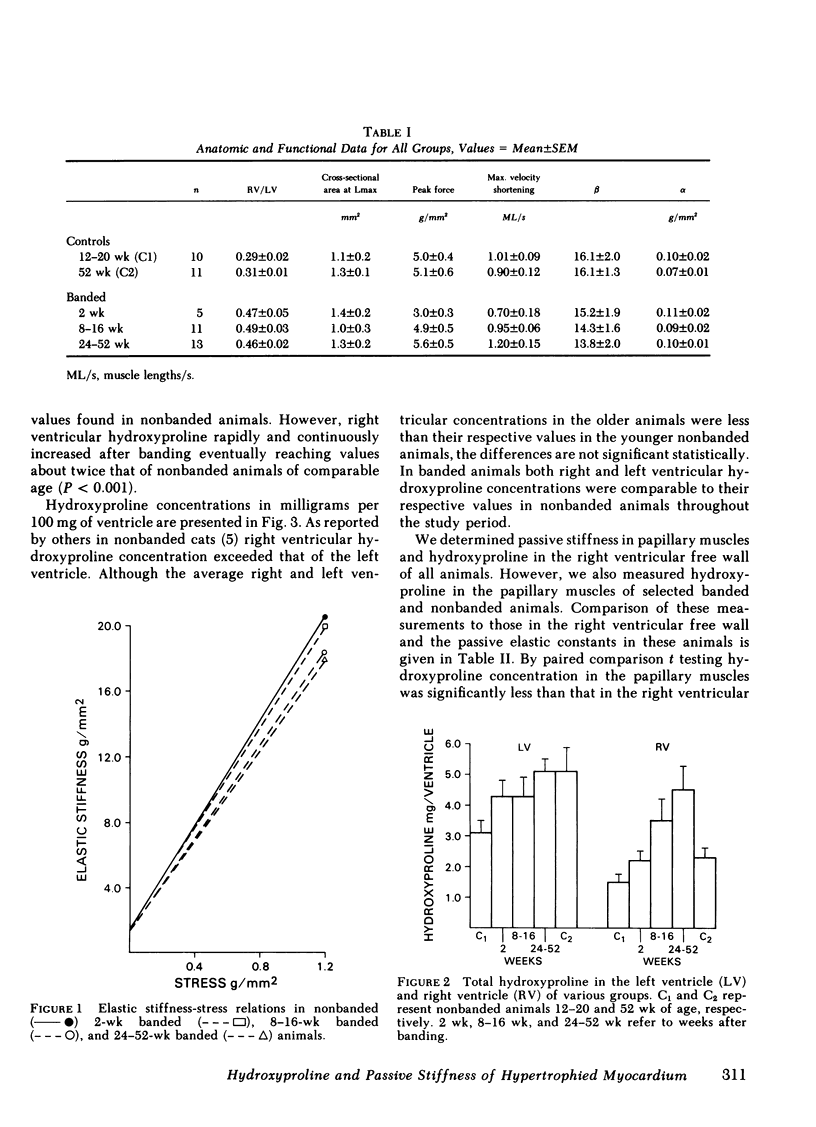
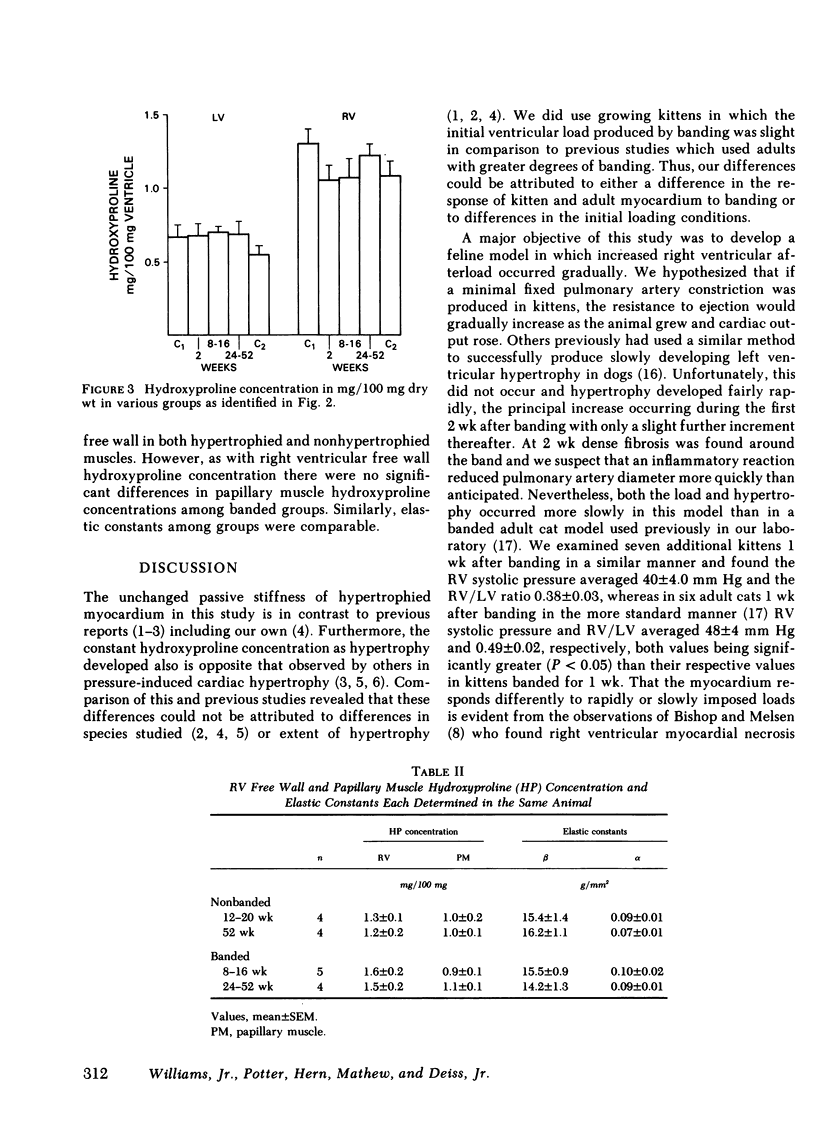
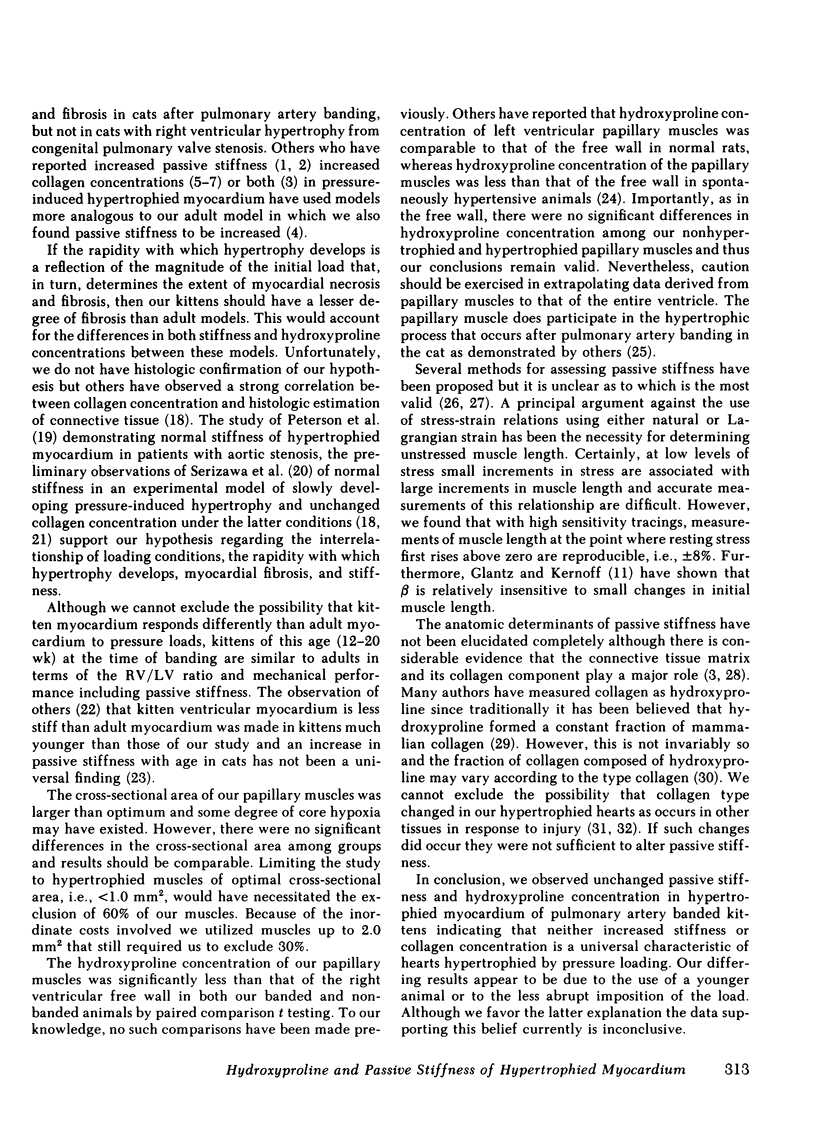
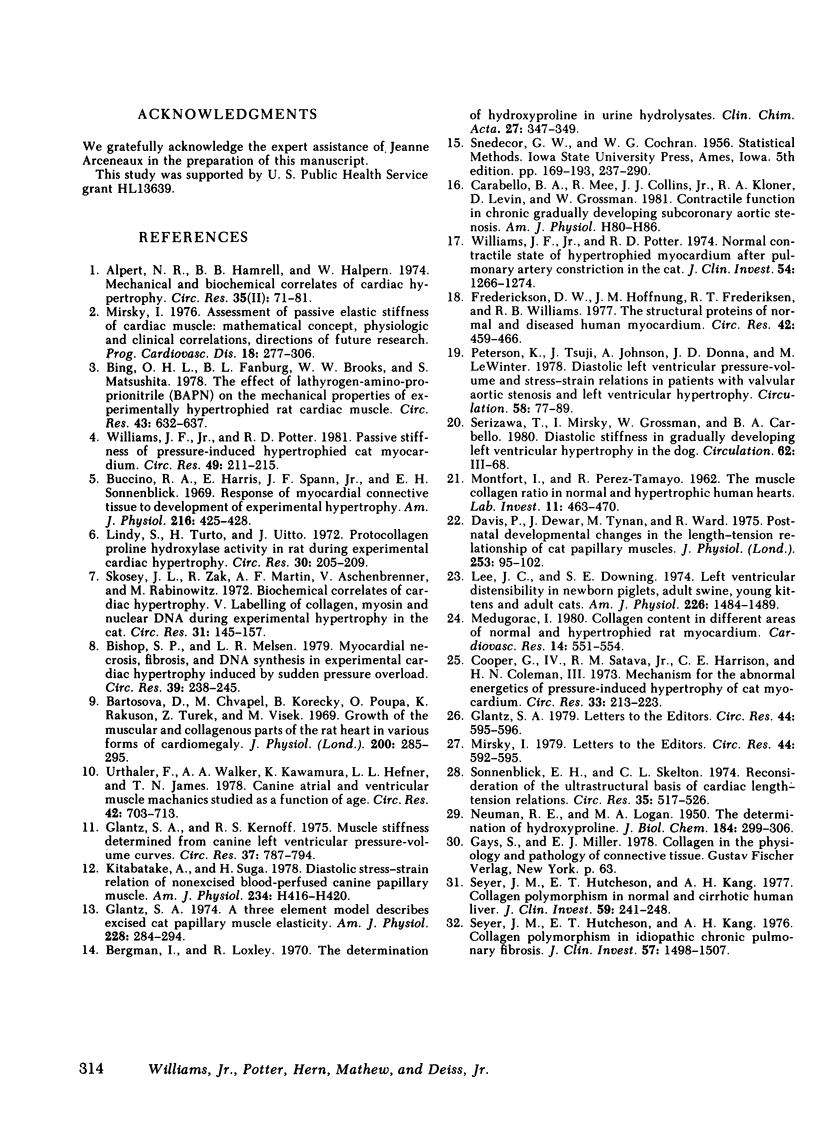
Selected References
These references are in PubMed. This may not be the complete list of references from this article.
- Alpert N. R., Hamrell B. B., Halpern W. Mechanical and biochemical correlates of cardiac hypertrophy. Circ Res. 1974 Aug;35(2):suppl II–II:82. [PubMed] [Google Scholar]
- Bartosová D., Chvapil M., Korecký B., Poupa O., Rakusan K., Turek Z., Vízek M. The growth of the muscular and collagenous parts of the rat heart in various forms of cardiomegaly. J Physiol. 1969 Feb;200(2):285–295. doi: 10.1113/jphysiol.1969.sp008693. [DOI] [PMC free article] [PubMed] [Google Scholar]
- Bergman I., Loxley R. The determination of hydroxyproline in urine hydrolysates. Clin Chim Acta. 1970 Feb;27(2):347–349. doi: 10.1016/0009-8981(70)90355-4. [DOI] [PubMed] [Google Scholar]
- Bing O. H., Fanburg B. L., Brooks W. W., Matsushita S. The effect of lathyrogen beta-amino proprionitrile (BAPN) on the mechanical properties of experimentally hypertrophied rat cardiac muscle. Circ Res. 1978 Oct;43(4):632–637. doi: 10.1161/01.res.43.4.632. [DOI] [PubMed] [Google Scholar]
- Bishop S. P., Melsen L. R. Myocardial necrosis, fibrosis, and DNA synthesis in experimental cardiac hypertrophy induced by sudden pressure overload. Circ Res. 1976 Aug;39(2):238–245. doi: 10.1161/01.res.39.2.238. [DOI] [PubMed] [Google Scholar]
- Buccino R. A., Harris E., Spann J. F., Jr, Sonnenblick E. H. Response of myocardial connective tissue to development of experimental hypertrophy. Am J Physiol. 1969 Feb;216(2):425–428. doi: 10.1152/ajplegacy.1969.216.2.425. [DOI] [PubMed] [Google Scholar]
- Cooper G., 4th, Satava R. M., Jr, Harrison C. E., Coleman H. N., 3rd Mechanisms for the abnormal energetics of pressure-induced hypertrophy of cat myocardium. Circ Res. 1973 Aug;33(2):213–223. doi: 10.1161/01.res.33.2.213. [DOI] [PubMed] [Google Scholar]
- Davies P., Dewar J., Tynan M., Ward R. Post-natal developmental changes in the length-tension relationship of cat papillary muscles. J Physiol. 1975 Dec;253(1):95–102. doi: 10.1113/jphysiol.1975.sp011181. [DOI] [PMC free article] [PubMed] [Google Scholar]
- Frederiksen D. W., Hoffnung J. M., Frederiksen R. T., Williams R. B. The structural proteins of normal and diseased human myocardium. Circ Res. 1978 Apr;42(4):459–466. doi: 10.1161/01.res.42.4.459. [DOI] [PubMed] [Google Scholar]
- Glantz S. A. A three-element model describes excised cat papillary muscle elasticity. Am J Physiol. 1975 Jan;228(1):284–294. doi: 10.1152/ajplegacy.1975.228.1.284. [DOI] [PubMed] [Google Scholar]
- Glantz S. A., Kernoff R. S. Muscle stiffness determined from canine left ventricular pressure-volume curves. Circ Res. 1975 Dec;37(6):787–794. doi: 10.1161/01.res.37.6.787. [DOI] [PubMed] [Google Scholar]
- Kitabatake A., Suga H. Diastolic stress-strain relation of nonexcised blood-perfused canine papillary muscle. Am J Physiol. 1978 Apr;234(4):H416–H420. doi: 10.1152/ajpheart.1978.234.4.H416. [DOI] [PubMed] [Google Scholar]
- Lee J. C., Downing S. E. Left ventricular distensibility in newborn piglets, adult swine, young kittens, and adult cats. Am J Physiol. 1974 Jun;226(6):1484–1489. doi: 10.1152/ajplegacy.1974.226.6.1484. [DOI] [PubMed] [Google Scholar]
- Lindy S., Turto H., Uitto J. Protocollagen proline hydroxylase activity in rat heart during experimental cardiac hypertrophy. Circ Res. 1972 Feb;30(2):205–209. doi: 10.1161/01.res.30.2.205. [DOI] [PubMed] [Google Scholar]
- MONTFORT I., PEREZ-TAMAYO R. The muscle-collagen ratio in normal and hypertrophic human hearts. Lab Invest. 1962 Jun;11:463–470. [PubMed] [Google Scholar]
- Medugorac I. Collagen content in different areas of normal and hypertrophied rat myocardium. Cardiovasc Res. 1980 Sep;14(9):551–554. doi: 10.1093/cvr/14.9.551. [DOI] [PubMed] [Google Scholar]
- Mirsky I. Assessment of passive elastic stiffness of cardiac muscle: mathematical concepts, physiologic and clinical considerations, directions of future research. Prog Cardiovasc Dis. 1976 Jan-Feb;18(4):277–308. doi: 10.1016/0033-0620(76)90023-2. [DOI] [PubMed] [Google Scholar]
- Mirsky I. Factors which affect the diastolic pressure-volume curve. Circ Res. 1979 Apr;44(4):592–595. doi: 10.1161/01.res.44.4.592. [DOI] [PubMed] [Google Scholar]
- NEUMAN R. E., LOGAN M. A. The determination of hydroxyproline. J Biol Chem. 1950 May;184(1):299–306. [PubMed] [Google Scholar]
- Peterson K. L., Tsuji J., Johnson A., DiDonna J., LeWinter M. Diastolic left ventricular pressure-volume and stress-strain relations in patients with valvular aortic stenosis and left ventricular hypertrophy. Circulation. 1978 Jul;58(1):77–89. doi: 10.1161/01.cir.58.1.77. [DOI] [PubMed] [Google Scholar]
- Seyer J. M., Hutcheson E. T., Kang A. H. Collagen polymorphism in idiopathic chronic pulmonary fibrosis. J Clin Invest. 1976 Jun;57(6):1498–1507. doi: 10.1172/JCI108420. [DOI] [PMC free article] [PubMed] [Google Scholar]
- Seyer J. M., Hutcheson E. T., Kang A. H. Collagen polymorphism in normal and cirrhotic human liver. J Clin Invest. 1977 Feb;59(2):241–248. doi: 10.1172/JCI108634. [DOI] [PMC free article] [PubMed] [Google Scholar]
- Skosey J. L., Zak R., Martin A. F., Aschenbrenner V., Rabinowitz M. Biochemical correlates of cardiac hypertrophy. V. Labeling of collagen, myosin, and nuclear DNA during experimental myocardial hypertrophy in the rat. Circ Res. 1972 Aug;31(2):145–157. doi: 10.1161/01.res.31.2.145. [DOI] [PubMed] [Google Scholar]
- Sonnenblick E. H., Skelton C. L. Reconsideration of the ultrastructural basis of cardiac length-tension relations. Circ Res. 1974 Oct;35(4):517–526. doi: 10.1161/01.res.35.4.517. [DOI] [PubMed] [Google Scholar]
- Urthaler F., Walker A. A., Kawamura K., Hefner L. L., James T. N. Canine atrial and ventricular muscle mechanics studied as a function of age. Circ Res. 1978 May;42(5):703–713. doi: 10.1161/01.res.42.5.703. [DOI] [PubMed] [Google Scholar]
- Williams J. F., Jr, Potter R. D. Normal contractile state of hypertrophied myocardium after pulmonary artery constriction in the cat. J Clin Invest. 1974 Dec;54(6):1266–1272. doi: 10.1172/JCI107871. [DOI] [PMC free article] [PubMed] [Google Scholar]
- Williams J. F., Jr, Potter R. D. Passive stiffness of pressure-induced hypertrophied cat myocardium. Circ Res. 1981 Jul;49(1):211–215. doi: 10.1161/01.res.49.1.211. [DOI] [PubMed] [Google Scholar]


